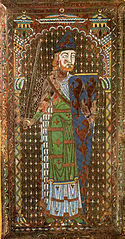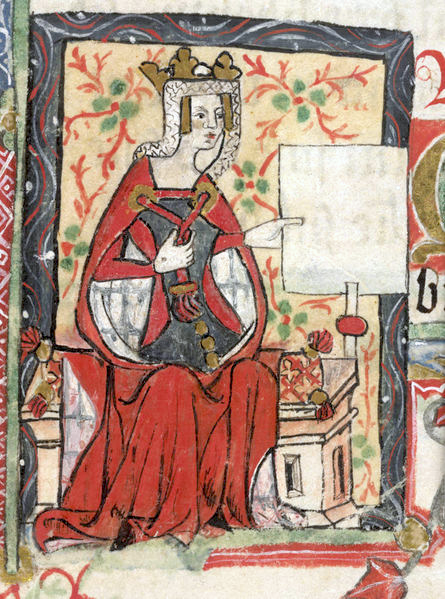 |
| Fulk IV of Anjou |
(1043-1109).
Count of Anjou
1068-1109.
Son of Geoffroi II of Gatinais & Ermengarde of Anjou, daughter of Fulk III the Black of Anjou.
Husband of:
1. Hildegarde de Beaugency, daughter of Lancelin II de Beaugency
2. Ermengarde de Bourbon, daughter of Archambaud IV de Bourbon, mar c1070, rep 1075
3. Aurengarde de Chateiiailon, daughter of Isembard de Chatel-Aillon, mar 1076, rep 1080
4. Unnamed daughter of Gautier I de Brienne, ar 1080, div 1087
5. Bertrade de Montfort, mar 1089
His lover was:
 |
Bertrade de Montfort Comtesse d'Anjou |
Bertrade de Montfort, Comtesse d'Anjou (1070-1117)
Wife of: Philippe I of France.
Freed by death from the man who would have been most likely to put obstacles in his path. Philip became bolder in his vices. He had married Bertha, daughter of the count of Flanders, and she had borne him several children; but growing weary of her, he treated her with the greatest neglect, and at length imprisoned her in the castle of Montreuil. In 1092 he was visiting Fulk, count of Anjou, at Tours, when he was introduced to the count's wife, Bertrade de Montfort, who was considered the most beautiful woman in the kingdom. The countess of Anjou had no affection for her husband; and when the king professed his admiration, she was easily induced to listen to the dictates of ambition. On one condition she would forsake Fulk and follow Philip to Orleans. She must be publicly accepted as the king's wife, and the so called marriage must have the sanction of the church, The king, though with great difficulty, prevailed on his bishops to perform the stipulated ceremony, and the Pope, Urban II, the successor of Gregory, lost no time in taking measures for the punishment of this outrageous offence A papal legate was sent to France, and at a national council assembled at Autun Philip and Bertrade were excommunicated, and Philip was forbidden to appear in public as a unless he would consent to separate from the countess The king, alarmed, laid aside his crown and sceptre, and implored forgiveness, but still he refused to give up Bertrade." (Popular History of France to the Death of Louis XIV: 74)
 |
| Geoffroy V of Anjou @Wikipedia |
(1113-1151)
Comte d'Anjou
1129-1151
"He also had illegitimate children, Hamelin de Warenne, later to become Duke of Salisbury, whose mother has been sometimes sourced as Adelaide of Angers, Emme, who married Dafydd Ab Owain Gwynedd, Prince of North Wales; and Mary, who became a nun and Abbess of Shaftesbury. He was also reputed to have indulged in an affair with his future daughter in law, Eleanor of Aquitaine, while she was the wife of Louis VII of France." (English Monarchs)
Son of Foulques V d'Anjou, King of Jerusalem & Erembourg du Maine
 |
| Matilda of England Countess of Anjou @Wikipedia |
Husband of Matilda of England (1102-1167), Empress of Germany, mar 1128, daughter of Henry I of England & Matilda of Scotland
His lovers were:
1) Unnamed mistress/es
Natural offspring:
a. Hamelin de Warenne, Earl of Surrey (1130-1202), mar Isabel de Warenne, 4th Countess of Surrey, mar 1164
b. Emme d'Anjou (1140-1214), mar 1174 Dafydd ab Owain Gwynedd, Prince of North Wales
c. Mary, Abbess of Shaftesbury
Elisabeth of Vendôme, Countess of Anjou (970-999)
Wife of Foulques III Nerra of Anjou.
"While Fulk's fortunes prospered on the diplomatic front, his domestic situation revealed a major difficulty. Countess Elizabeth of Vendome, after almost fifteen years of marriage, had failed to produce a male heir, and the couple's prayers supported by gifts to powerful saints had been in vain. MOreover, Elizabeth seems to have taken a lover. Whether she was simply trying to produce the required son or had become alienated from Fulk is not clear. In any event, when Elizabeth realized that Fulk had learned of her activities, she seized control of the citadel at Angers with a handful of supporters and held it against her husband. (This seizure may perhaps indicate a conspiracy involving her brother or her father.) Fulk established a siege in the course of which Elizabeth fell from the high walls and was captured. Fulk had her immmediately burned for adultery, and a few days later he tried to dislodge the remainder of her supporters by setting the citadel on fire. . . ." (Bachrach. Fulk Nerra, the Neo-Roman Consul 987-1040: 76)
No comments:
Post a Comment